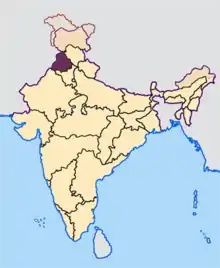Vaisakhi
Vaisakhi (IAST: vaisākhī), also pronounced as Baisakhi marks the beginning of Hindu solar New year.[3][4] Vaisakhi marks the first day of the month of Vaisakha and is usually celebrated on 13 or 14 April every year. This holiday also is known as Vaisakha Sankranti and celebrates the Solar new year, based on the Hindu Vikram Samvat calendar. It is additionally a spring harvest festival for many Indians.[5]
| Vaisakhi | |
|---|---|
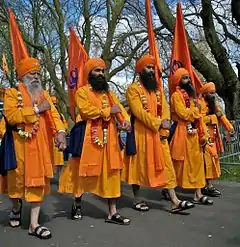 Vaisakhi celebrations by Sikhs | |
| Also called | Vaisakh(few people also call this festival as baisakhi) |
| Observed by | Hindus and Sikhs |
| Type | religious, cultural |
| Significance | Hindu Solar New Year,[1] Harvest festival, birth of the Khalsa, Punjabi new year |
| Celebrations | Fairs, Ritual Bathing, Amrit Sanchaar (baptism) for new Khalsa, Parades and Nagar Kirtan |
| Observances | Prayers, processions, raising of the Nishan Sahib flag, Fairs,dancing in the farms etc. |
| 2020 date | Mon, 13 April[2] |
| Related to | South and Southeast Asian solar New Year |
Vaisakhi is also a historical and religious festival in Hinduism and Sikhism. It is usually celebrated on 13 or 14 April every year. [6][7][8][9][10][1][11][12]
For Hindus, the festival is their traditional solar new year, a harvest festival, an occasion to bath in sacred rivers such as Ganges, Jhelum, and Kaveri, visit temples, meet friends and take part in other festivities. In other parts of India, the Vaisakhi festival is known by various regional names.[13]
For Sikhs, Vaisakhi observes major events in the history of Sikhism and the Indian subcontinent that happened in the Punjab region.[14][15] The significance of Vaisakhi as a major Sikh festival marking the birth of Sikh order started after the persecution and execution of Guru Tegh Bahadur for refusing to convert to Islam under the orders of the Mughal Emperor Aurangzeb. This triggered the coronation of the tenth Guru of Sikhism and the historic formation of Khalsa, both on the Vaisakhi day.[16][17][18] Ranjit Singh was proclaimed as Maharaja of the Sikh Empire on 12 April 1801 (to coincide with Vaisakhi), creating a unified political state. Sahib Singh Bedi, a descendant of Guru Nanak dev, conducted the coronation.[19] Vaisakhi was also the day when the British colonial empire official, General Reginald Dyer, committed the Jallianwala Bagh massacre on a gathering, an event influential to the Indian movement against colonial rule.[14]
On Vaisakhi, Gurdwaras and Mandirs are decorated. Sikhs hold kirtans, visit local Gurdwaras, community fairs and nagar kirtan processions are held, and people gather to socialize and share festive foods.[7][14][20]
Date
Vaisakhi is traditionally observed on 13 or 14 April, every year. The festival coincides with other new year festivals celebrated on the first day of Vaisakh in other regions of the Indian Subcontinent such as the Pohela Boishakh, Bohag Bihu, Vishu, Puthandu among others.[21][22]
Spelling and pronunciation
The spelling varies with region. In Punjab region, Vaisakhi is common, but in the Doabi and Malwai dialects, speakers often substitute a B for a V.[23] The spelling used depends on the dialect of the writer.[24]
Khalsa tradition started in the year 1699,[14] as it is on this day that the 10th Guru of the Sikhs, Guru Gobind Singh laid down the foundation of the Panth Khalsa, that is the Order of the Pure Ones, by baptizing Sikh warriors to defend religious freedoms.[25][26][27] This gave rise to the Vaisakhi or Baisakhi festival being observed as a celebration of Khalsa panth formation and is also known as Khalsa Sirjana Divas[28] and Khalsa Sajna Divas.[29] The festival is celebrated on Vaisakhi day (typically 14 April), since 1699. The Birth of the Khalsa Panth was either on 13 April 1699[30] or 30 March 1699.[31] Since 2003, the Sikh Gurdwara Prabhandak Committee named it Baisakh (Vaisakh), making the first day of the second month of Vaisakh according to its new Nanakshahi calendar.[32]
A special celebration takes place at Talwandi Sabo (where Guru Gobind Singh stayed for nine months and completed the recompilation of the Guru Granth Sahib),[33] in the Gurudwara at Anandpur Sahib the birthplace of the Khalsa, and at the Golden Temple in Amritsar.
Sikh New Year
According to the Khalsa sambat, the Khalsa calendar starts with the creation of the Khalsa which is 1 Vaisakh 1756 Bikrami (30 March 1699).[34][35] Accordingly, Vaisakhi has been the traditional Sikh New Year.[10][1][36] The festival has been traditionally observed in the Punjab region.[37][38] The alternative Nanakshahi calendar begins its year a month earlier on 1 Chait which generally falls on 14 March and begins with the birth year of the Guru Nanak Dev in 1469.[39]
Nagar Kirtan
Sikh communities organise processions called nagar kirtan (literally, "town hymn singing"). These are led by five khalsa who represent the Panj Pyaare, and the processions through the streets. The people who march sing, make music, sing hymns from the Sikh texts. Major processions also carry a copy of the Guru Granth Sahib in reverence.[11]
Harvest festival

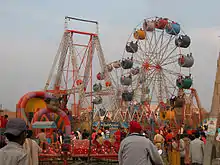
Vaisakhi is a harvest festival for people of the Punjab region.[40] In the Punjab, Vaisakhi marks the ripening of the rabi harvest.[41] Vaisakhi also marks the Punjabi new year.[42] This day is observed as a thanksgiving day by farmers whereby farmers pay their tribute, thanking God for the abundant harvest and also praying for future prosperity.[43] The harvest festival is celebrated by Sikhs and Punjabi Hindus.[44] Historically, during the early 20th century, Vaisakhi was a sacred day for Sikhs and Hindus and a secular festival for all Muslims and non-Muslims including Punjabi Christians.[45] In modern times, sometimes Christians participate in Baisakhi celebrations along with Sikhs and Hindus.[46]
Aawat pauni
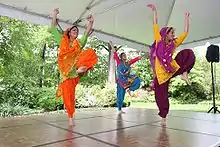
Aawat pauni is a tradition associated with harvesting, which involves people getting together to harvest the wheat. Drums are played while people work. At the end of the day, people sing dohay to the tunes of the drum.[47]
Fairs and dances
The harvest festival is also characterized by the folk dance, Bhangra which traditionally is a harvest dance.
Fairs or Melas (fair) are held in many parts of Punjab, India to mark the new year and the harvesting season. Vaisakhi fairs take place in various places, including Jammu City, Kathua, Udhampur, Reasi and Samba,[48] in the Pinjore complex near Chandigarh,[49] in Himachal Pradesh cities of Rewalsar, Shimla, Mandi and Prashar Lakes.
Sikhism
Vaisakhi (Punjabi: ਵੈਸਾਖੀ or ਵਸਾਖੀ, vaisĝkhī, is, as well, known as Baisakhi), it is a very important day for Sikhs and one of the most colourful events in the Sikh calendar. It occurs during mid-April every year and traditionally concurs in Punjab with the first harvesting of the crops for the year. So, historically, it has been a very joyous occasion and a time for celebration. However, since 1699, it has marked the very significant religious event of the creation of the Khalsa Panth.
Vaisakhi falls in the Nanakshahi calendar on the first day of the Vaisakh month and marks the sun's entering of Mesha Rasi (this fact is called Mesha Sankranti, i.e. the solar transits into Aries). Vaisakhi is therefore determined by the solar calendar. Baisakhi usually falls on April 14, and on April 15 once every thirty-six years, however, it has now been agreed for Vaisakhi to always fall on the 14th of April. It is not, as commonly believed, a New Year for the Sikhs. This Sikh New Year is celebrated on the 1st day of Chet which usually falls on March 13, a month earlier.
Religious persecution under Aurangzeb
A younger son of Shah Jahan, Aurangzeb, seized the Gaddi (Throne) of the Mughal Empire from his brother Dara Shikoh, arrested his father and took the Imperial name of Alamgir I (seizer of the Universe, besting his father who had styled himself Grabber of the World) in 1657. His coming to the throne had been costly for his family members, now it would become a disaster for the people of India and those who dared to challenge his policy of religious persecution as he set in motion the process of the Islamization of India.
The Brahmins were his primary target but he reinstated the unethical religious tax, that Akbar had ended, on the Hindus. Their temples and places of learning were shut, torn down and often replaced with Masjids, often built from the stones of the Hindu Temples. He had been convinced by the powerful ulama, whom his predecessors had largely ignored, that once the highly respected Brahmins of Kashmir accepted Islam, the Hindus of all castes would then follow suit.
1675: The fight against Persecution
The Brahmins of Kashmir were given an ultimatum— convert or die. Thoughts of death, rape and torture for themselves and loved ones weighed heavily on their minds. When the time allotted for their answer was almost up, they looked for a dynamic leader to help in their fight against subversion.
The Kashmiri Brahmins, led by Pandit Kirpa Ram sought the intervention of Guru Tegh Bahadur, the ninth Nanak or preceptor of the Sikh religion — the Dasvin Patishah or Guru, in his new city, near the ruins of ancient Makhowal, — today's Anandpur Sahib. They asked him for guidance on combating the atrocities being committed by the Mughal Emperor.
At the time of their meeting, Guru Tegh Bahadur's nine-year-old son, Gobind Rai, was sitting beside him. As Guru Tegh Bahadur was deep in contemplation, thinking of the problem, his young son asked the reason of his concern. Guru Tegh Bahadur said that the matter was of vital importance; the world is aggrieved by oppression; and no brave man had yet come forward who was willing to sacrifice his life to free the earth from the burden of Aurangzeb's persecution. Young Gobind Rai replied, "For that purpose who is more worthy than you my father." So after entrusting the Guruship to Gobind Rai, Guru Tegh Bahadur and several of his Sikhs proceeded to Delhi, the seat of the Mughal Empire. But, before reaching Delhi, the Guru and his loyal attendants were arrested and put in chains by the agents of the Mughal Ruler Aurangzeb.
The martyrdom of Guru Tegh Bahadur
While in prison, Guru Tegh Bahadur foresaw the beginning of his ecclesiastic journey. To test his son's courage and capability to carry on the Guru's mission, he wrote him saying, "My strength is exhausted, I am in chains and I can make not any efforts. Says Nanak, God alone is now my refuge. He will help me as He did his Saints." In reply young Guru Gobind Rai wrote: "I have regained my Power, my bonds are broken and all options are open unto me. Nanak, everything is in Thine hands. It is only Thou who can assist Thyself."
Guru Teg Bahadur offered his life for the freedom of all, not just his own group of Sikhs, but for those of another religion to be able to freely choose when, where and how they would hold their worship. His spirit of sacrifice and courage kindled a similar spirit in the heart of young Gobind Rai.
It was November 11, hundreds of people had gathered around Chandini Chowk where Guru Tegh Bahadur was martyred in Delhi. The executioner left the Guru's severed head and body to lie where they had fallen. In fear of a sudden sand storm he had run for shelter. No one stood up to claim the body of the fallen Guru or his companions who had died tortured deaths before his eyes. Who would perform the religious rites of these brave men. Even the most ardent disciples withdrew, unrecognized.
But, taking advantage of the stormy weather one man, a member of the Mazhabis, managed to take the severed head of Tegh Bahadur to his family back in Anandpur where the appropriate rites were given the noble Guru. Another man, assisted by his sons, secreted the Guru's body away before it would surely be quartered or hung on display by Aurangzeb's minions. They used their humble home as the Guru's secret funeral pyre, as any proper cremation would have brought down the wrath of the frustrated Aurangzeb on their heads. Aurangzeb had lost in this challenge to his plans--for Guru Tegh Bahadur had endured all of the tortures and lures that the mighty Aurangzeb could muster, niether he or any of his companions had taken the easier road and abandoned their religion and principles. Gobind Rai would now seek to endow each of his Sikhs with the iron will and fortitude of his father. For the moment the Pandits were safe, but Guru Gobind Rai now worked to prepare his Sikhs for the coming storm.
1675– : Guru Gobind Rai leads the moral struggle
With the criteria of courage and strength to sacrifice, Gobind Rai became the tenth Sikh Guru. He wanted to instill these principles in his downtrodden followers. He wanted to uplift their morale to combat the evil forces of injustice, tyranny, and oppression.
Every year at the time of Baisakhi (springtime), thousands of devotees would come to Anandpur to pay their obeisance and seek the Guru's blessings.
1699: Guru Gobind Rai (Singh) establishes the Khalsa
Guru Gobind Rai was 33 years old when he had Divine inspiration to actuate his designs. In early 1699, months before Baisakhi Day, Guru Gobind Rai sent special edicts to congregations far and wide telling all the Sangats that that year's Baisakhi was going to be a unique affair. He asked them not to cut any of their hair — to come with unshorn hair under their turbans and chunis, and for the men to come with full beards.
On Baisakhi Day, March 30, 1699, hundreds of thousands of people gathered around his divine temporal seat at Anandpur Sahib. The Guru addressed the congregants with a most stirring oration on his divine mission of restoring their faith and preserving the Sikh religion. After his inspirational discourse, he flashed his unsheathed sword and said that every great deed was preceded by an equally great sacrifice: Then calling out to the assembled crowd, 'My sword is hungry for a head', He demanded one head for oblation. After some trepidation one person offered himself for the Guru's 'great sacrifice'. The Guru took him inside a tent. A little later the Guru came out of the tent, his sword dripping with fresh blood only to ask for another head. One by one four more earnest devotees offered their heads. Every time the Guru took a person inside the tent, he came out with his sword dripping fresh blood.
Thinking their Guru had gone mad and afraid He would ask for more heads some of the congregation started to disperse when suddenly the Guru emerged with all five men dressed piously in white and in a new ceremony that changed the way that one became a Sikh the Guru now initiated the five into a new and unique order of Sikhs. The ceremony was called pahul, what Sikhs today know as the baptism ceremony or Amrit Shakna. Then the Guru asked the first five Khalsa Sikhs to baptise him, in the same manner. He then proclaimed that the Panj Pyare -- the Five Beloved Ones -- would be the embodiment of the Guru himself:
And so, as it was carried out on that historic day, the ceremony of Pahul continues to this day.
The important thing to remember about that day is that the five volunteers and the whole sangat thought or were "under the impression" that the five Sikhs were really walking to their deaths--being killed, one by one. The Sikhs who volunteered, had demonstrated their willingness to give their heads--in the same way that Guru Tegh Bahadur had done that day in Delhi. The Guru's bit of showmanship, his seemingly--all to real test, was performed to prove the devotion and dedication of his Sikhs. Those who were ready to give themselves up to their Guru were the bravest and most devoted. These brave men had unkowningly chosen to be part of a new paanth - the Khalsa Panth. Guru ji joined the Khalsa Panth after his devoted Sikhs - the initiator becoming the initiated. Today, as then, they lead the Khalsa alongside the Guru: 1699 Amrit Sanchaar He said whenever and wherever five baptised (Amritdhari) Sikhs come together, the Guru would be present. All those who receive Amrit from five baptized Sikhs will be infused with the spirit of courage and strength to sacrifice. Thus with these principles he established Panth Khalsa, the Order of the Pure Ones.
At the same time the Guru gave his new Khalsa a unique, indisputable, and distinct identity. The Guru gave the gift of bana, the distinctive Sikh clothing and headwear. He also offered five emblems of purity and courage. These symbols, worn by all baptised Sikhs of both sexes, are popularly known today as Five Ks: Kesh, unshorn hair; Kangha, the wooden comb; Karra, the iron (or steel) bracelet; Kirpan, the sword; and Kachera, the underwear. By being identifiable, no Sikh could never hide behind cowardice again.
Political tyranny was not the only circumstance that was lowering peoples' morale. Discriminatory class distinctions (--the Indian "caste" system--) promoted by Brahmins and Mullahs was also responsible for the peoples' sense of degradation. The Guru wanted to eliminate the anomalies caused by the caste system. The constitution of the Panj Pyare was the living example of his dream: both the high and low castes were amalgamated into one. Among the original Panj Pyare, there was one Khatri, shopkeeper; one Jat, farmer; one Chhimba, calico printer/tailor; one Ghumar, water-carrier; and one Nai, a barber. The Guru gave the surname of Singh (Lion) to every Sikh and also took the name for himself. From Guru Gobind Rai he became Guru Gobind Singh. He also pronounced that all Sikh women embody royalty, and gave them the surname Kaur (Princess). With the distinct Khalsa identity and consciousness of purity Guru Gobind Singh gave all Sikhs the opportunity to live lives of courage, sacrifice, and equality.
Panj Pyare
PANJ PIARE (literally the five beloved ones), name given to the five Sikhs, Bhai Daya Singh, Bhai Dharam Singh, Bhai Himmat Singh, Bhai Mukham Singh and Bhai Sahib Singh, who were so designated by Guru Gobind Singh at the historic divan at Anandpur Sahib on 30 March 1699 and who formed the nucleus of the Khalsa as the first batch to receive at his hands khanda di Pahul, i.e. rites of the two-edged sword.
In Sikh theology, as in the Indian classical tradition generally, panj or panch, the numeral five, has a special significance. Guru Nanak in Japji refers to five khands, i.e. stages or steps in spiritual development, and calls a spiritually awakened person a panch. The ancient Indian socio-political institution panchayat meant a council of five elders. Something like an inner council of five existed even in the time of the earlier Gurus: five Sikhs accompanied Guru Arjan on his last journey to Lahore; the five were each given 100 armed Sikhs to command by his successor, Guru Hargobind; Guru Tegh Bahadur, set out on his journey to Delhi to court execution attended by five Sikhs.
Until the Baisakhi of AD 1699, Sikh initiation ceremony, charan pahul, comprised the administering of charanamrit or charanodak to the novitiate. As Bhai Gurdas, Varan, I.23, records, this was the practice Guru Nanak introduced for the Sikhs. At the ceremony the novitiate quaffed water poured over the foot of the Guru and vowed to follow the religious and moral injunctions as well as the code of communal conduct laid down. Later, masands or local leaders, specially authorized by the Gurus, also administered charan pahul. According to Kesar Singh Chhibbar, Bansavalinama, a modification was introduced in the time of Guru Hargobind when water, poured over the toe of the right foot of each of the five chosen Sikhs assembled in a dharamsal, was received in a bowl and administered to the seekers after ardas or supplicatory prayer.
Panj Mukte
During Nagar Kirtans there are always two sets of 5 people one being the Panj Pyare and one the Panj Mukte. The Panj Pyare carry kirpans while the Panj Mukte have Nishan Sahibs. The Panj Mukte or five liberated ones (mukte), is a batch of five Sikhs, who according to Bhai Daya Singh's Rahitndmd, were the first after the Panj Piare to receive the rites of Khalsa initiation at the hands of Guru Gobind Singh on the historic Baisakhi day of AD 1699.
- Ram Singh
- Fateh Singh
- Deva Singh
- Tahil Singh
- Ishar Singh
According to Bhai Chaupa Singh, the Rahitnama Hazuri, usually ascribed to him, was originally drafted by the muktds. No other details of these five are available except that an old manuscript of Bhai Prahilad Singh's Rahitnama is said to contain a note associating Ram Singh and Deva Singh with the village of Bughiana, in Lahore district, Tahil Singh and Isar Singh with DallVari, in presentday Amritsar district and F'ateh Singh with Khurdpur Marigat, perhaps the same as Guru Marigat in Lahore district. The name of Ram Singh also occurs among the twentyfive mukte mentioned in Kuir Singh, Gurbilds Pdtshdhl 10. According to Sarup Singh Kaushish, Guru kida Sakhidn, a Bhatt source, Deva Singh and Isar Singh fell martyrs in the battle of Chamkaur on 7 December 1705.
Hinduism
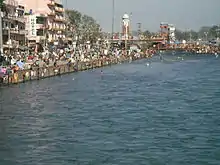
For Hindus, the first day of Vaisakh marks the traditional solar new year[50][51] and it is an ancient festival that predates the founding of Sikhism. The harvest is complete and crops ready to sell, representing a time of plenty for the farmers. Fairs and special thanksgiving pujas (prayers) are common in the Hindu tradition.[52]
The first day of Vaisakh marks the solar new year.[53] It is the New Year's Day for Hindus in Assam, Bengal, Bihar, Himachal Pradesh, Haryana, Kerala, Odisha, Punjab[54] Tamil Nadu, Uttar Pradesh, Uttrakhand and other parts of India.[53][22] However, this is not the universal new year for all Hindus. For some, such as those in and near Gujarat, the new year festivities coincide with the five-day Diwali festival.[22] For others, the new year falls on Cheti Chand, Gudi Padwa and Ugadi which falls a few weeks earlier.[22][55]
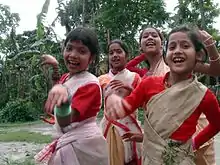
It is regionally known by many names among the Hindus, though the festivities and its significance is similar. It is celebrated by Hindus bathing in sacred rivers, as they believe that river goddess Ganges descended to earth on Vaisakhi from Svarga.[52][56] Some rivers considered particularly sacred include the Ganges, Jhelum and Kaveri. Hindus visit temples, meet friends and party over festive foods.[13]
Vaisakhi coincides with the festival of 'Vishu' and 'Puthandu' celebrated in Kerala and Tamilnadu a day after Vaisakhi. The festivities include fireworks, shopping for new clothes and interesting displays called 'Vishu Kani'. Hindus make arrangements of flowers, grains, fruits which friends and family visit to admire as "lucky sight" (Vishukkani). Giving gifts to friends and loved ones, as well as alms to the needy, are a tradition of Kerala Hindus on this festive day.[13]
Vaisakhi is celebrated as Bohag (Rongali) Bihu in Assam and as Pohela Boishakh in Bengal, but typically one or two days after Vaisakhi.[57]
Regional variations
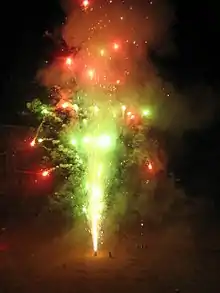
The following is a list of new year festivals:[53][58][22]
- Bikhu (Bikhauti) in the Kumaon region of Uttarakhand, India
- Bisu – Tulu New Year Day amongst the Tulu people in India
- Bohag Bihu in Assam, India
- Edmyaar 1 (Bisu Changrandi) – Kodava New Year.
- Jude Sheetal in Mithila (parts of Nepal and Bihar, India)
- Pana Sankranti (Maha Vishuba Sankranti) in Odisha, India
- Pohela Boishakh in West Bengal and Tripura, India, Nepal and Bangladesh
- Puthandu in Tamil Nadu, India
- Ugadi in Andhra Pradesh, Karnataka and Telangana, India
- Vishu in Kerala, India
The new year falls on or about the same day every year for many Buddhist communities in parts of South and Southeast Asia. This is likely an influence of their shared culture in the 1st millennium CE.[22] Some examples include:
- Aluth Avuruthu in Sri Lanka.[59]
- Nepal Sambat(Vaishak Ek) in Nepal
- Chol Chnam Thmey in Cambodia
- Pi Mai in Laos
- Songkran in Thailand
- Thingyan in Myanmar
Bikhoti festival
The Bikhoti Festival of Uttrakhand involves people taking a dip in holy rivers. A popular custom involves beating symbolic stones representing demons with sticks. The fair is celebrated in various major centres including Sealdah, Bageshwar and Dwarahat and involves much singing and dancing, accompanied by local drums and other instruments.[60]
Vishu
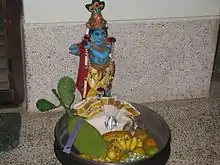
Vishu is a Hindu festival celebrated on the same day as Vaisakhi in the Indian state of Kerala, and falls on the first day of Malayali month called Medam.[61][62] The festival is notable for its solemnity and the general lack of pomp and show that characterize other Hindu festivals of Kerala such as Onam.[61][63]
The festival is marked by family time, preparing colorful auspicious items and viewing these as the first thing on the Vishu day. In particular, Malayali Hindus seek to view the golden blossoms of the Indian laburnum (Kani Konna), money or silver items (Vishukkaineetam), and rice.[61][63] The day also attracts firework play by children,[61][64] wearing new clothes (Puthukodi) and the eating a special meal called Sadya, which is a mix of salty, sweet, sour and bitter items.[65] The Vishu arrangement typically includes an image of Vishnu, typically as Krishna. People also visit temples on the day.[66]
Bohag Bihu
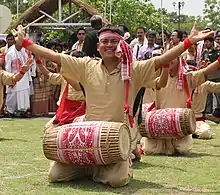
Bohag Bihu or Rangali Bihu marks the beginning of the Assamese New Year on 13 April. It is celebrated for seven days Vishuva Sankranti (Mesha Sankranti) of the month of Vaisakh or locally 'Bohag' (Bhaskar Calendar). The three primary types of Bihu are Rongali Bihu, Kongali Bihu, and Bhogali Bihu. Each festival historically recognizes a different agricultural cycle of the paddy crops. During Rangali Bihu there are 7 pinnacle phases: 'Chot', 'Raati', 'Goru', 'Manuh', 'Kutum', 'Mela' and 'Chera'.[67]
Maha Vishuba Sankranti
Pana Sankranti (ପଣା ସଂକ୍ରାନ୍ତି) also known as Maha Vishuba Sankranti marks the Odia new year in Odisha. Celebrations include various types of folk and classical dances, such as the Shiva-related Chhau dance.[68] On this day people hang pieces of Neem branches with leaves in front of their houses believed to have health benefits. They prepare a liquid mixture of jaggery, mango, pepper and other ingredients which is called Pana(ପଣା). An earthen pot with a small hole and a grass(କୁୁଶ) within the hole at the bottom is hung over the Tulasi (ତୁୁୁଳସୀ ଚଉରା). The pot is filled with water daily which acts as a drip to protect the sacred plant from the summer heat.[69]
Poyla Baishakh

The Bengali new year is celebrated as Poyla Baishakh on 14 April every year, and a festive Mangal Shobhajatra, started by students of Dhaka University in Bangladesh in 1989,[70] is organized in the Indian states of West Bengal and Tripura, as well as modern-day nation of Bangladesh. This celebration was listed in 2016 by the UNESCO as a cultural heritage of humanity.[71][72]
The festival is celebrated as a national holiday in Bangladesh. Also spelled Pohela Boishakh is also known as Nobo Barsho as it is the first day of the Bengali month of Bongabdo. Fairs are organised to celebrate the event which provides entertainment including the presentation of folk songs.[73]
Puthandu
Puthandu, also known as Puthuvarusham or Tamil New Year, is the first day of the month Chithirai on the Tamil calendar.[74][75][59]
On this day, Tamil people greet each other by saying "Puttāṇṭu vāḻttukkaḷ!" or "Iṉiya puttāṇṭu nalvāḻttukkaḷ!", which is equivalent to "Happy new year".[76] The day is observed as a family time. Households clean up the house, prepare a tray with fruits, flowers and auspicious items, light up the family Puja altar and visit their local temples. People wear new clothes and youngster go to elders to pay respects and seek their blessings, then the family sits down to a vegetarian feast.[77]
Sikh celebrations outside India
Pakistan
Pakistan has many sites that are of historic importance to the Sikh faith, such as the birthplace of Guru Nanak. These sites attract pilgrims from India and abroad every year on Vaisakhi.[80][81] Pakistan used to have many more Sikhs, but a vast majority moved to India during the 1947 India-Pakistan partition. Contemporary Pakistan has about 20,000 Sikhs in a total population of about 200 million Pakistanis, or about 0.01%.[82] These Sikhs, and thousands more who arrive from other parts of the world for pilgrimage, observe Vaisakhi in Western Punjab (Pakistan) with festivities centered on the Panja Sahib complex in Hasan Abdal, Gurudwaras in Nankana Sahib, and in various historical sites in Lahore.[83][note 1]
According to Aziz-ud-din Ahmed, Lahore used to have Baisakhi Mela after the harvesting of the wheat crop in April. However, adds Ahmed, the city started losing its cultural vibrancy in 1970s after Zia-ul-Haq came to power, and in recent years "the Pakistan Muslim League (N) government in Punjab banned kite flying through an official edict more under the pressure of those who want a puritanical version of Islam to be practiced in the name of religion than anything else".[87] Unlike the Indian state of Punjab that recognizes the Vaisakhi Sikh festival as an official holiday,[88] the festival is not an official holiday in Punjab or Sindh provinces of Pakistan as Sikhs constitute a very small number in terms of population.[89][90]
Canada
In the Province of British Columbia, large, local Sikh communities in the cities of Vancouver, Abbotsford, and Surrey hold their annual Vaisakhi celebrations in April,[91] which include two Nagar Kirtan (parades). The Vancouver parade starts at Ross Street Temple[92] and makes its way through the traditional Punjabi Market in South Vancouver.[93] One week later, the festival in Surrey is one of the largest such celebrations outside of India, having attracted over 200,000 people in 2014,[94] over 350,000 in 2015, and approached 400,000 in 2016. The 2017 attendance in Surrey reportedly topped 400,000, causing organizers to consider future distribution of the festival over several days and local cities, particularly in areas of economic disadvantage which would benefit from the generous charitable efforts seen during Vaisakhi celebrations.[95][96] Record attendance was again experienced in April 2018 in the 20th annual Surrey Vaisakhi parade, with the RCMP officially estimating the crowd at over half a million people in a city with a 2016 census population of 517,887.[97] Starting at the Gurdwara Dashmesh Darbar Temple (12885 85th Avenue in Surrey), the parade features a variety of floats, community groups, free food, live music and dancers and performers, and travels along 124th Street, turns left onto 75th Avenue, continues on 76th Avenue, onto 128th Street, then back to the Temple.[98] Kelowna's annual Vaisakhi parade is held a week after Surrey's parade each year and begins and ends at the Sikh Temple on Rutland Road.[99] Victoria's all-day Vaisakhi celebration features a parade that begins and ends at Gurdwara Singh Sabha, 470 Cecelia Road. The 2018 celebrations on 29 April would be the first held in Victoria in over 100 years.[100]
In the Province of Alberta, the Edmonton Vaisakhi parade is held in May and travels between the Gurdwara Singh Sabha (4504 Millwoods Road S) & Gurdwara Millwoods (2606 Millwoods Road E) temples.[101]
In the Province of Nova Scotia, the Halifax-based Maritime Sikh Society holds Vaisakhi celebrations in April featuring Shabad Kirtan performed by professional ragis (musicians).[102]
In the Province of Ontario, the Toronto Vaisakhi Parade is held in April, starting at the Canadian National Exhibition grounds and traveling east to Toronto City Hall, finishing almost three hours later. Following the parade, dignitaries address the gathering until late afternoon.[103] In the city of Malton, a three-hour Nagar Kirtan parade winds from Morning Star, Goreway, Derry Rd, & Airport Rd to Malton Gurdwara Sahib. In the city of Brampton, the Gurudwara Sikh Sangat temple and Gobind Sarvar Gurmat School hold Vaisakhi cultural events such as yoga, pagh (turban) tying, storytelling, and food fairs.[104]
In the Province of Saskatchewan, the Saskatoon Vaisakhi parade is held in May, starting and ending at the Gurudwara Sahib Temple at 331 Lowe Road.[105]
United Kingdom
The United Kingdom has a large Sikh community originating from the Indian sub-continent, East Africa[106] and Afghanistan. The largest concentrations of Sikhs in the UK are to be found in the West Midlands (especially Birmingham and Wolverhampton) and London.[107] The Southall Nagar Kirtan is held on a Sunday a week or two before Vaisakhi. The Birmingham Nagar Kirtan is held in late April in association with Birmingham City Council,[108] and is an annual event attracting thousands of people which commences with two separate nagar kirtans setting off from gurdwaras in the city and culminating in the Vaisakhi Mela at Handsworth Park.[109]
United States
Amongst Sikh populations in the United States, there is usually a parade commemorating the Vaisakhi celebration. In Manhattan, New York City[110] people come out to do "Seva" (selfless service) such as giving out free food, and completing any other labor that needs to be done. In Los Angeles, California, the local Sikh community consisting of many gurdwaras[111] holds a full day Kirtan (spiritual music) program followed by a parade.
Malaysia
The Sikh community, a subgroup of the Malaysian Indian ethnic minority race, is an ethnoreligious minority in Malaysia, which is why Vaisakhi is not a public holiday. However, in line with the government's efforts to promote integration among the country's different ethnic and religious groups, the prime minister, Najib Razak has announced that beginning 2013, all government servants from the Sikh Malaysian Indian community will be given a day off on Vaisakhi Day.[112] Vaisakhi 'open houses' are also held across the country during the day of the festival, or the closest weekend to it.
Notes
- On 8 April 2016, Punjabi Parchar at Alhamra (Lahore) organised a show called Visakhi mela, where the speakers pledged to "continue our struggle to keep the Punjabi culture alive" in Pakistan through events such as Visakhi Mela.[84] Elsewhere Besakhi fairs or melas are held in various places including Eminabad[85] and Dera Ghazi Khan.[86]
References
- William Owen Cole; Piara Singh Sambhi (1995). The Sikhs: Their Religious Beliefs and Practices. Sussex Academic Press. p. 63. ISBN 978-1-898723-13-4., Quote: "The Sikh new year, Vaisakhi, occurs at Sangrand in April, usually on the thirteenth day."
- "April 2020 Official Central Government Holiday Calendar". Government of India. Retrieved 17 December 2017.
- Rinehart, Robin; Rinehart, Robert (2004). Contemporary Hinduism: Ritual, Culture, and Practice. ABC-CLIO. ISBN 978-1-57607-905-8.
- Kelly, Aidan A.; Dresser, Peter D.; Ross, Linda M. (1993). Religious Holidays and Calendars: An Encyclopaedic Handbook. Omnigraphics, Incorporated. ISBN 978-1-55888-348-2.
- BBC Religions (2009), Vaisakhi and the Khalsa
- Harjinder Singh. Vaisakhi. Akaal Publishers. p. 2.
- K.R. Gupta; Amita Gupta (2006). Concise Encyclopaedia of India. Atlantic Publishers. p. 998. ISBN 978-81-269-0639-0.
- Bodiwala, Suresh (18 November 2017). "Sikh Religious Society Organizes Two -day Conference in Chicago to Implement Mool Nanakshahi Calendar". Chicago Tribune. Archived from the original on 20 November 2017.
- Harbans Singh (1 January 1998). The Encyclopaedia of Sikhism: S-Z. Publications Bureau. ISBN 978-81-7380-530-1.
- Cath Senker (2007). My Sikh Year. The Rosen Publishing Group. p. 10. ISBN 978-1-4042-3733-9., At Vaisakhi, Sikhs remember how their community, the Khalsa, first began."
- BBC Religions (2009), Vaisakhi and the Khalsa
- Knut A. Jacobsen (2008). South Asian Religions on Display: Religious Processions in South Asia and in the Diaspora. Routledge. p. 192. ISBN 978-1-134-07459-4., Quote: "Vaisakhi is also a Hindu festival, but for the Sikhs, it celebrates the foundation of the Khalsa in 1699."
- Christian Roy (2005). Traditional Festivals: A Multicultural Encyclopedia. ABC-CLIO. pp. 479–480. ISBN 978-1-57607-089-5.
- S. R. Bakshi, Sita Ram Sharma, S. Gajnani (1998) Parkash Singh Badal: Chief Minister of Punjab. APH Publishing pages 208–209
- William Owen Cole; Piara Singh Sambhi (1995). The Sikhs: Their Religious Beliefs and Practices. Sussex Academic Press. pp. 135–136. ISBN 978-1-898723-13-4.
- Seiple, Chris (2013). The Routledge handbook of religion and security. New York: Routledge. p. 96. ISBN 978-0-415-66744-9.
- Pashaura Singh and Louis Fenech (2014). The Oxford handbook of Sikh studies. Oxford, UK: Oxford University Press. pp. 236–237. ISBN 978-0-19-969930-8.
- Harkirat S. Hansra (2007). Liberty at Stake, Sikhs: the Most Visible. iUniverse. pp. 28–29. ISBN 978-0-595-43222-6.
- The Encyclopaedia of Sikhism Archived 8 May 2014 at the Wayback Machine, section Sāhib Siṅgh Bedī, Bābā (1756–1834).
- Jonathan H. X. Lee; Kathleen M. Nadeau (2011). Encyclopedia of Asian American Folklore and Folklife. ABC-CLIO. pp. 1012–1013. ISBN 978-0-313-35066-5.
- Crump, William D. (2014), Encyclopedia of New Year's Holidays Worldwide, MacFarland, page 114
- Karen Pechilis; Selva J. Raj (2013). South Asian Religions: Tradition and Today. Routledge. pp. 48–49. ISBN 978-0-415-44851-2.
- "Archived copy". Archived from the original on 4 March 2016. Retrieved 26 November 2014.CS1 maint: archived copy as title (link)
- "Pronunciation of Vaisakhi".
- Pashaura Singh (2005), Understanding the Martyrdom of Guru Arjan, Journal of Punjab Studies, 12(1), pages 29–62
- Johar, Surinder (1999). Guru Gobind Singh: A Multi-faceted Personality. M.D. Publications. p. 89. ISBN 978-8175330931.
- Singh Gandhi, Surjit (2008). History of Sikh Gurus Retold: 1606 -1708. Atlantic Publishers. pp. 676–677. ISBN 978-8126908578.
- Laws of the State of Illinois Enacted by the ... General Assembly at the Extra Session. (2013) State Printers. page 7772
- Singh, Jagraj (2009) A Complete Guide to Sikhism. Unistar Books page 311
- Purewal, Pal. "Vaisakhi Dates Range According To Indian Ephemeris By Swamikannu Pillai – i.e. English Date on 1 Vaisakh Bikrami" (PDF). www.purewal.biz. Retrieved 13 April 2016.
- Kaur, Madanjit (2007). Unistar Books Guru Gobind Singh: Historical and Ideological Perspective, page 149
- W. H. McLeod (2009). The A to Z of Sikhism. Scarecrow Press. pp. 143–144. ISBN 978-0-8108-6344-6.
- Tribune News service (14 April 2009). "Vaisakhi celebrated with fervour, gaiety". The Tribune, Chandigarh.
- Dogra, Ramesh Chander and Dogra, Urmila (2003) Page 248 The Sikh World: An Encyclopedic Survey of Sikh Religion and Culture. UBS Publishers Distributors Pvt Ltd ISBN 81-7476-443-7
- The Panjab in 1839–40: selections from the Punjab akhbars, Punjab intelligence, etc., preserved in the National Archives of India, New Delhi (1952) Sikh History Society
- Nick Hunter (2016). Celebrating Sikh Festivals. Raintree. p. 10. ISBN 978-1-4062-9776-8.
- Brown, Alan (1986). Festivals in World Religions. Longman. ISBN 9780582361966. Retrieved 14 September 2016 – via Google Books.
- Simon J Bronner (2015), Routledge Encyclopedia of American Folklife, page 1132
- Kapel, Marin (2006) The Structure and Mathematics of the Principal Calendars of the Western World: Muslim, Gregorian, Jewish, and Other Systems. Edwin Mellen Press
- Bakshi, S. R. Sharma, Sita Ram (1998) Parkash Singh Badal: Chief Minister of Punjab
- Dogra, Ramesh Chander and Dogra, Urmila (2003) Page 49 The Sikh World: An Encyclopedic Survey of Sikh Religion and Culture. UBS Publishers Distributors Pvt Ltd ISBN 81-7476-443-7
- Sainik Samachar: The Pictorial Weekly of the Armed Forces, Volume 33 (1986) Director of Public Relations, Ministry of Defence,
- Dhillon, (2015) Janamsakhis: Ageless Stories, Timeless Values. Hay House
- Gupta, Surendra K. (1999) Indians in Thailand, Books India International
- "Link: Indian Newsmagazine". 13 April 1987 – via Google Books.
- Nahar, Emanual (2007) Minority politics in India: role and impact of Christians in Punjab politics. Arun Pub. House.
- Dr Singh, Sadhu (2010) Punjabi Boli Di Virasat. Chetna Prakashan. ISBN 817883618-1
- "Baisakhi celebrated with fervour, gaiety in J&K". 14 April 2015. Retrieved 14 September 2016.
- Punia, Bijender K. (1 January 1994). Tourism Management: Problems and Prospects. APH Publishing. ISBN 9788170246435. Retrieved 14 September 2016 – via Google Books.
- Rao, S. Balachandra (1 January 2000). Indian Astronomy: An Introduction. Universities Press. ISBN 9788173712050. Retrieved 14 September 2016 – via Google Books.
- Tribune 15 April 2011 Baisakhi fervour at Haridwar Lakhs take dip in holy Ganga
- Robin Rinehart (2004). Contemporary Hinduism: Ritual, Culture, and Practice. ABC-CLIO. p. 139. ISBN 978-1-57607-905-8.
- "BBC – Religion: Hinduism – Vaisakhi". BBC. Retrieved 22 January 2012.
- Crump, William D. (2014) Encyclopedia of New Year's Holidays Worldwide. McFarland
- Mark-Anthony Falzon (2004). Cosmopolitan Connections: The Sindhi Diaspora, 1860–2000. BRILL. p. 62. ISBN 90-04-14008-5.
- Lochtefeld, James G. (1 January 2002). The Illustrated Encyclopedia of Hinduism: A-M. The Rosen Publishing Group. ISBN 9780823931798. Retrieved 14 September 2016 – via Google Books.
- "2017 Official Central Government Holiday Calendar" (PDF). Government of India. Retrieved 4 March 2017.
- Crump, William D. (2014), Encyclopedia of New Year's Holidays Worldwide, MacFarland, page 114
- Peter Reeves (2014). The Encyclopedia of the Sri Lankan Diaspora. Didier Millet. p. 174. ISBN 978-981-4260-83-1.
- "Festivals and Culture".
- Major festivals of Kerala, Government of Kerala (2016)
- J. Gordon Melton (2011). Religious Celebrations: An Encyclopedia of Holidays, Festivals, Solemn Observances, and Spiritual Commemorations. ABC-CLIO. p. 633. ISBN 978-1-59884-206-7.
- Maithily Jagannathan (2005). South Indian Hindu Festivals and Traditions. Abhinav Publications. pp. 76–77. ISBN 978-81-7017-415-8.
- "City celebrates Vishu". The Hindu. 16 April 2010. Retrieved 27 September 2013.
- "When the Laburnum blooms". The Hindu. 14 April 2011. Retrieved 27 September 2013.
- Roshen Dalal (2010). Hinduism: An Alphabetical Guide. Penguin Books. p. 461. ISBN 978-0-14-341421-6.
- "Bohag Bihu". Britannica.
- Sitakant Mahapatra (1993). Chhau Dance of Mayurbhanj. Vidyapuri. p. 86.
- "Odisha celebrates New Year Maha Vishuva Sankranti". The Hindu.
- "'Mongol Shobhajatra' parades city streets". The Financial Express Online Version. Retrieved 16 April 2017.
- Mangal Shobhajatra on Pahela Baishakh, UNESCO
- "Unesco lists Mangal Shobhajatra as cultural heritage". The Daily Star. 1 December 2016. Retrieved 16 April 2017.
- "Pahela Baishakh celebrated". The daily star.
- Roshen Dalal (2010). Hinduism: An Alphabetical Guide. Penguin Books. p. 406. ISBN 978-0-14-341421-6.
- J. Gordon Melton (2011). Religious Celebrations: An Encyclopedia of Holidays, Festivals, Solemn Observances, and Spiritual Commemorations. ABC-CLIO. p. 633. ISBN 978-1-59884-206-7.
- William D. Crump (2014). Encyclopedia of New Year's Holidays Worldwide. McFarland. p. 220. ISBN 978-0-7864-9545-0.
- Samuel S. Dhoraisingam (2006). Peranakan Indians of Singapore and Melaka. Institute of Southeast Asian Studies. p. 38. ISBN 978-981-230-346-2.
- Hari Bansh Jha (1993) The terai community and national integration in Nepal.
- Ethnobotany. Aavishkar Publishers, Distributors. 1 January 2002. ISBN 9788179100257 – via Google Books.
- Glare and galore at Baisakhi festival, The Dawn, Pakistan (15 April 2015)
- Vaisakhi 2015: Sikh devotees celebrate major festival in India and Pakistan, David Sims, International Business Times
- Ary News 17 April 2015 Sikh pligrims gather in Pakistan for Vaisakhi festival
- Muhammad Najeeb Hasan Abdal (12 April 2008). "Sikh throng Pakistan shrine for Vaisakhi". Thaindian News. www.thaindian.com. Retrieved 22 January 2012.
- Pakistan Today (8 April 2016) Punjabi Parchar spreads colours of love at Visakhi Mela
- "A fair dedicated to animal lovers". DAWN.COM. 20 April 2009.
- Agnes Ziegler, Akhtar Mummunka (2006) The final Frontier: unique photographs of Pakistan. Sang-e-Meel Publications
- Cultural Decline in Pakistan, Pakistan Today, Aziz-ud-din Ahmed (21 February 2015)
- Official Holidays, Government of Punjab, India (2016)
- Official Holidays 2016, Government of Punjab – Pakistan (2016)
- Official Holidays 2016, Karachi Metropolitan, Sindh, Pakistan
- Global News 12 April 2015 Vaisakhi celebrated at parade in south Vancouver
- "Khalsa Diwan Society | Vancouver".
- "Thousands brighten Vancouver streets to mark Vaisakhi". CBC News. Retrieved 24 April 2018.
- VancouverDesi.com 14 April 2015 What you need to know about the Vaisakhi parade
- "Surrey's Vaisakhi parade draws record attendance in massive celebration of diversity and inclusion". Vancouver Sun. Retrieved 21 April 2017.
- "Up to 400K people expected to attend 2017 Surrey Vaisakhi parade". CBC News. Retrieved 21 April 2017.
- "Surrey's Vaisakhi parade biggest ever". North Delta Reporter. Retrieved 24 April 2018.
- "Surrey Vaisakhi Parade Map". Retrieved 24 April 2018.
- "Vaisakhi Parade Saturday". Castanet. Retrieved 25 April 2018.
- "After 100 years, Vaisakhi returns to Victoria". CBC. Retrieved 28 April 2018.
- "Vaisakhi 2018". Retrieved 24 April 2018.
- "Maritime Sikh Society – About Us". Retrieved 28 April 2018.
- "Khalsa Day Parade Celebrate the founding of the Sikh community. at Better Living Centre". Retrieved 24 April 2018.
- "Vaisakhi Cultural Food Fair". Retrieved 24 April 2018.
- "1st-ever Saskatoon Sikh Parade was so busy it spurred a traffic advisory". Retrieved 28 April 2018.
- S. K. Rait (2005) Sikh Women in England: Their Religious and Cultural Beliefs and Social Practices
- Amarjeet Singh (2014) Indian Diaspora: Voices of Grandparents and Grandparenting
- Council, Birmingham City. "Things to do – Birmingham City Council". Retrieved 14 September 2016.
- "Thousands join Sikh Vaisakhi celebrations in Birmingham". BBC News. 22 April 2012. Retrieved 10 May 2012.
- "Annual NYC Sikh Day Parade". www.nycsikhdayparade.com. 30 April 2012. Archived from the original on 22 March 2012. Retrieved 22 January 2012.
- "Baisakhi – Guru Ram Das Ashram". Retrieved 14 September 2016.
- "Sikh civil servants get Vaisakhi holiday". The Star Online. 8 May 2012. Retrieved 15 February 2013.

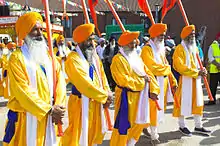

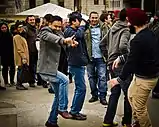





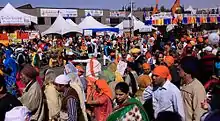
.jpg.webp)
.jpg.webp)
